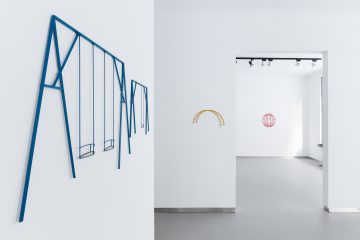Almost all of us remember well the typical housing estate playgrounds of late socialism. These battle-scarred climbing frames, torn swings, squeaking squirrels or balance swings on flat tyres, not exactly in line with EU comfort standards, still evoke in all of us childhood memories of fun or sadness. Marcell Németh has such memories, but he did not start making miniature copies of these toys merely out of nostalgia for the old playgrounds in the housing estates. As with his earlier stegies, his new “reliefs” were born in the context of a thoughtful exploration of the basic experiences of the artificial and the natural, the bounded and the free, the measured and the infinite.
These playground elements, which are almost reminiscent of models, and the “spaces” and “grounds” constructed from them on the walls of the exhibition space, are not merely intended to trick the visitor’s senses. In addition to presenting an illusory spectacle, the model-like, artistic nature of the play elements also reveals the act of creation and presentation. Németh reveals the already artificial nature of the playground through the artificiality of the model-like elements. In his creations, the emphasis is not on the tension between reality and its representation in art, but rather on the affinity between visual representation and artificial reality.
His illusionism is based on the change of scale of each piece, creating the perspective of an imaginary playground. A kind of staged space is created in the exhibition space. But the change of scale is also a dissonant element in the illusion. For a long time, the sense of space cannot be maintained in the viewer’s eyes: the perspective becomes suspicious with the deliberate changes in proportion, and gradually reveals itself. Németh’s intention is therefore not to deceive the viewer, but rather to force a game by evoking the collective memory of the playground.
This self-revealing genre is on the borderline between documentary and fiction. Partly true, it evokes a memory we all share. Partly false, because it deceives our senses by being illusory. This recurring change of state of the ensemble, this oscillation between visual illusion and documentary character, is a common feature of Németh’s scenic works, which forces the viewer to examine the spaces depicted more closely.
The play of the sense of the to-and-fro, of the partly true and partly false, is also a characteristic of the Deleuzian simulacrum, not a kind of unnatural deception, but an illusion that engages the viewer, demands his attention and possesses him. In Németh’s work, this illusion is authenticated by the way in which the world constructed in his material is structured in exact perspective, but the contradictions that emerge in the analysis of the model – the frequent changes of scale, the frequent changes of the points of infinity and the frequent changes of the scale of the points of infinity – are not always the same.
